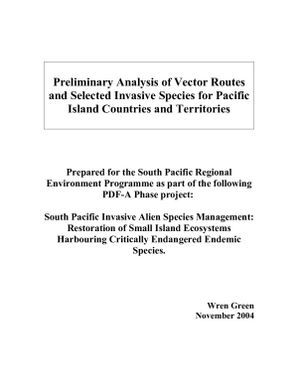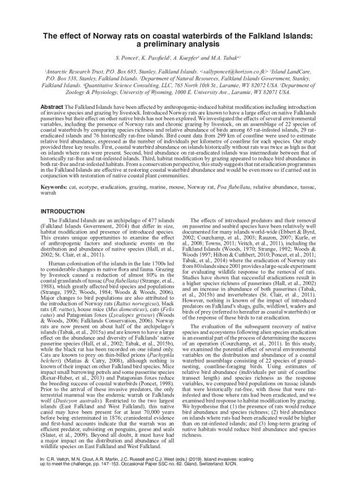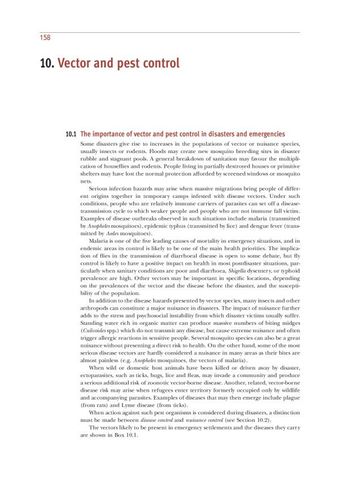Preliminary Analysis of Vector Routes and Selected Invasive Species for Pacific Island Countries and Territories
- Description:
- Understanding vector routes for invasive species (i.e. the routes by which pest plants and animals move from place to place via human assistance) is a key element in global and national efforts to reduce risks and limit the further spread of invasive species. This report is divided into two main sections. The first section provides a quantitative analysis of air and sea movements between the countries and territories of the Pacific. The second section summarises information on eighty existing or potential invasive plants and animals to Pacific islands. While the GEF project with which this report is linked is limited to SPREP countries, the analysis also includes the territories of the region (with the exception of Pitcairn Island). This is essential since some territories are pivotal to understanding vector routes and transport hubs in the region. For the same reason, flights from Pacific islands to Hawaii are included, as well as including Hawaii in the analysis of the selected invasive species. There is significant variability in the volume and patterns of ship movements and aircraft flights between the countries and territories of the Pacific, which is consistent with their diverse sizes, economies, exports, and political linkages. A few countries emerged as significant hubs for sea and air transport within the region. (Refer to Tables 1 and 2 for summaries.) In the northern Pacific, Guam emerges as the high risk country, given its high levels of total merchant ship and oceanic fishing vessels as well as the largest number of weekly flights to other Pacific island countries (139) and to Asian destinations (148). In the central southern Pacific, Fiji is the major transport centre with a large volume of merchant shipping, cruise liners and itinerant yachts (585 yearly visits) and relatively high numbers of weekly flights both within and outside the region. To the east, French Polynesia has a smaller annual number of merchant ship visits, but when other shipping activity is included, as well as 26 weekly flights to the USA (including Hawaii) and more within the region, it emerges as an important vector route. (It already has a significant number of invasive species). Papua New Guinea and New Caledonia are important countries in the western Pacific for shipping volumes; New Caledonia also for visits by yachts (500/yr). Papua New Guinea has extensive air links with Australia, another source of tropical invasives, but very few within the Pacific. New Caledonia has a larger number of weekly flights than Papua New Guinea spread within the region, as well as to Asian, Australian and New Zealand destinations. The information in the second section on eighty invasive species provides evidence for the links between trade, travel and the distribution of invasives. Vector routes and methods of spread are identified. It also highlights the importance of early detection and eradication if Pacific countries are to be more effective at limiting the arrival and spread of invasive species.
- Display date:
- 2004
- Collections:
- Secretariat of the Pacific Regional Environment Programme (SPREP)
- Publisher:
- South Pacific Invasive Alien Species Management
- Content partner:
- Secretariat of the Pacific Regional Environment Programme (SPREP)
- Availability:
- Not specified
-
Copyright status: All rights reservedFind out more about what you are able to do with this itemThis item is all rights reserved, with means you'll have to get permission from Secretariat of the Pacific Regional Environment Programme (SPREP) before using it. For more information, please see our use and reuse page.What can I do with this item?Non-infringing useNZ copyright law does not prevent every use of a copyright work, and this item may be hosted by an international institute or organisation. You should consider what you can and cannot do with a copyright work.No sharingYou may not copy and/or share this item with others without further permission. This includes posting it on your blog, using it in a presentation, or any other public use.No modifyingYou are not allowed to adapt or remix this item into any other works.No commercial useYou may not use this item commercially.
Related items
Welcome and warm Pasifik greetings
The information on this site has been gathered from our content partners.
The names, terms, and labels that we present on the site may contain images or voices of deceased persons and may also reflect the bias, norms, and perspective of the period of time in which they were created. We accept that these may not be appropriate today.
If you have any concerns or questions about an item, please contact us.


